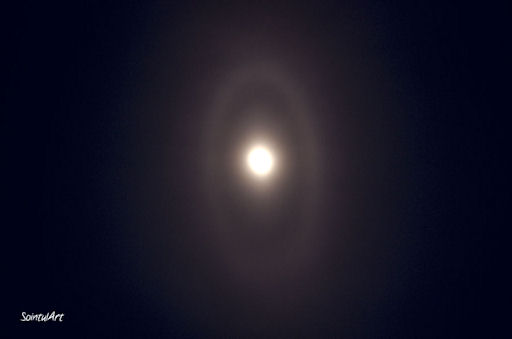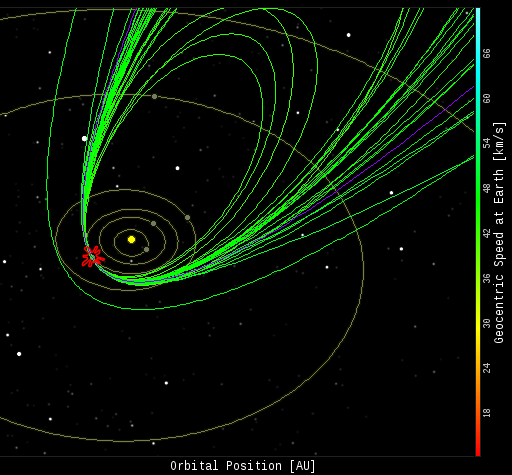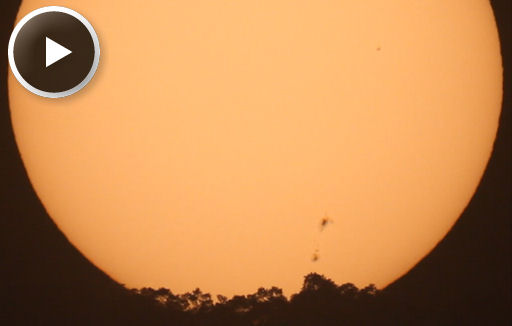Listen to radar echoes from satellites and meteors, live on listener-supported Space Weather Radio. | | |
HUBBLE SEES COMET ISON: A new picture of Comet ISON taken by the Hubble Space Telescope is giving astronomers key information about what might happen when the comet plunges into the sun later this year. See the picture
ELLIPTICAL MOON HALOS: The moon is waxing full, which means now is the time to be alert for icy moon halos. On April 22nd, Darryl Luscombe of Sointula, British Columbia, saw an unusual specimen. Instead of being circular, as usual, this halo was elliptical:

"I dont think I have ever seen an elliptical halo around the moon before," says Luscombe. "I looked up and just stared for about a minute. Then I raced inside to get my camera. I just managed to photograph it before it disappeared."
Atmospheric optics expert Les Cowley comments on the apparition: "There have been quite a few ellipticals seen in the last few weeks both in Europe and the US. Something strange [is happening] in all our skies!"
"These unusual ice halos are much smaller than the ordinary 22 degree halo encircling the sun or moon," Cowley continues. "In the 22 degree halo the ring is effectively made by light refracting through a 60 degree ice prism. The smaller elliptical halos need much narrower prisms and we think that six sided plate shaped crystals with very shallow pyramidal ends might do the work. The problem is that such crystals are unphysical and computer simulations using them do not predict the halo very well. An alternative is the wedge shaped sections of small snowflake-like crystals. Whatever their cause, they are rare and mysterious!"
Realtime Space Weather Photo Gallery
LYRID FIREBALLS: For the past few days, Earth has been passing through a stream of debris from ancient Comet Thatcher, source of the annual Lyrid meteor shower. According to international observers, the encounter produced as many as 25 meteors per hour. Some of these were fireballs. NASA's All Sky Fireball Network detected more than 30 Lyrids as bright as Venus on the nights around the shower's April 22nd peak. Here are their orbits:

In the diagram, the red splat marks the location of Earth; green elipses are the orbits of the meteoroids, triangulated by multiple cameras in the meteor network.
"The purple ellipse is the orbit of Comet Thatcher," adds Bill Cooke, lead scientist for NASA's Meteoroid Environment Office. "The orbits of the comet and the meteoroids match up nicely." According to Cooke, the Lyrid fireballs penetrated Earth's atmosphere as deeply as 44 miles above the planet's surface, traveling at an average speed of 105,000 mph.
The shower is subsiding now as Earth exits the debris stream.
Realtime Meteor Photo Gallery
BIG SUNSPOT: Fast-growing sunspot AR1726 is now so large that people are noticing it as blemish on the solar disk, visible when the sun is dimmed at sunrise or sunset. Bartholomew Tsang sends this evening snapshot from the Ho Koon Nature Education cum Astronomical Centre in Hong Kong:

The behemoth active region, which spans more than 150,000 km from end to end, has a delta-class magnetic field that harbors energy for strong eruptions. NOAA forecasters estimate 40% chance of M-class solar flares and a 15% chance of X-flares during the next 24 hours. Solar flare alerts: text, voice.
Realtime Aurora Photo Gallery
Realtime Comet Photo Gallery
Realtime Noctilucent Cloud Photo Gallery
[previous years: 2003, 2004, 2005, 2006, 2007, 2008, 2009, 2011]

